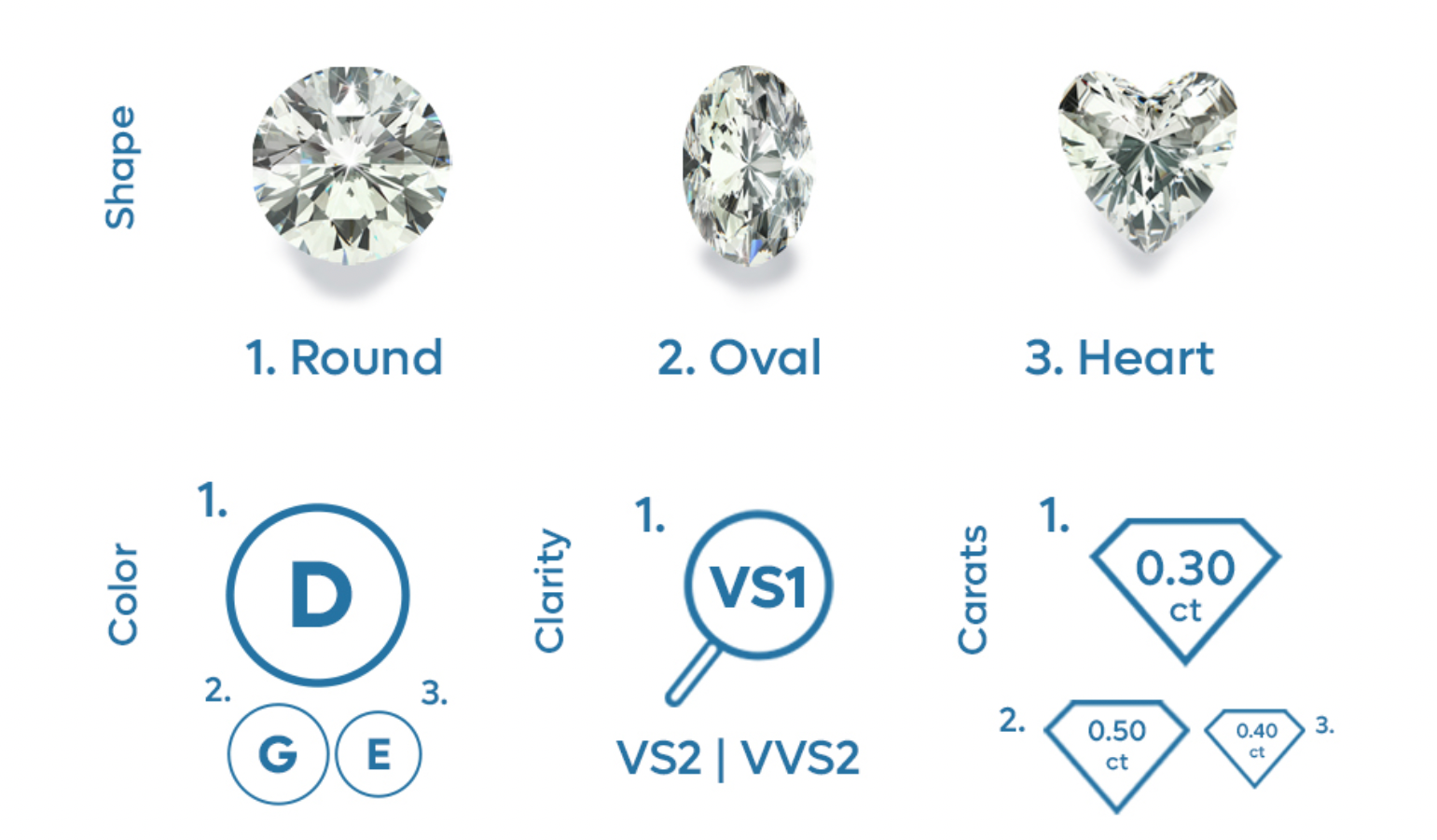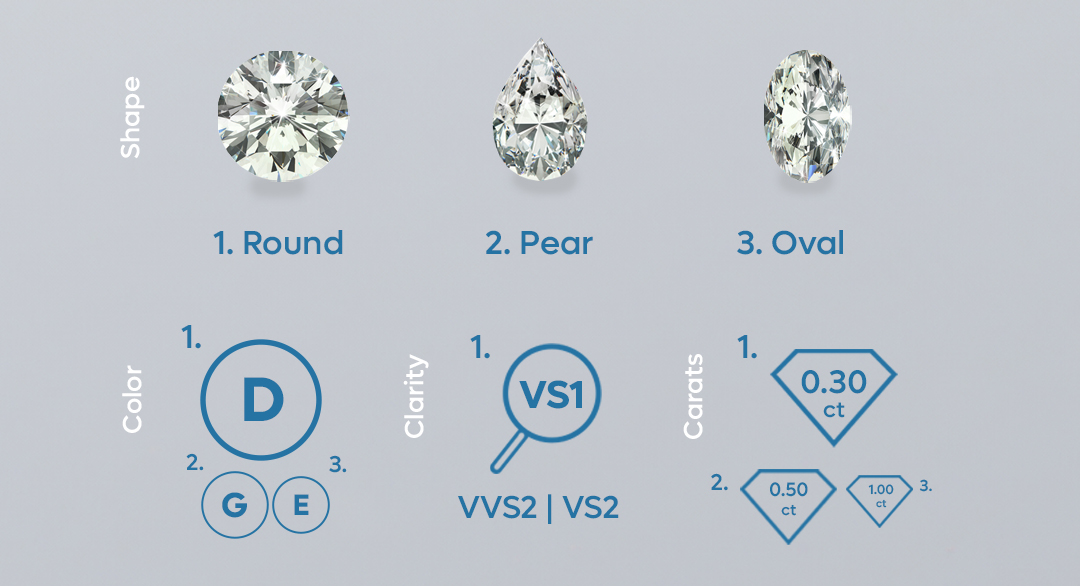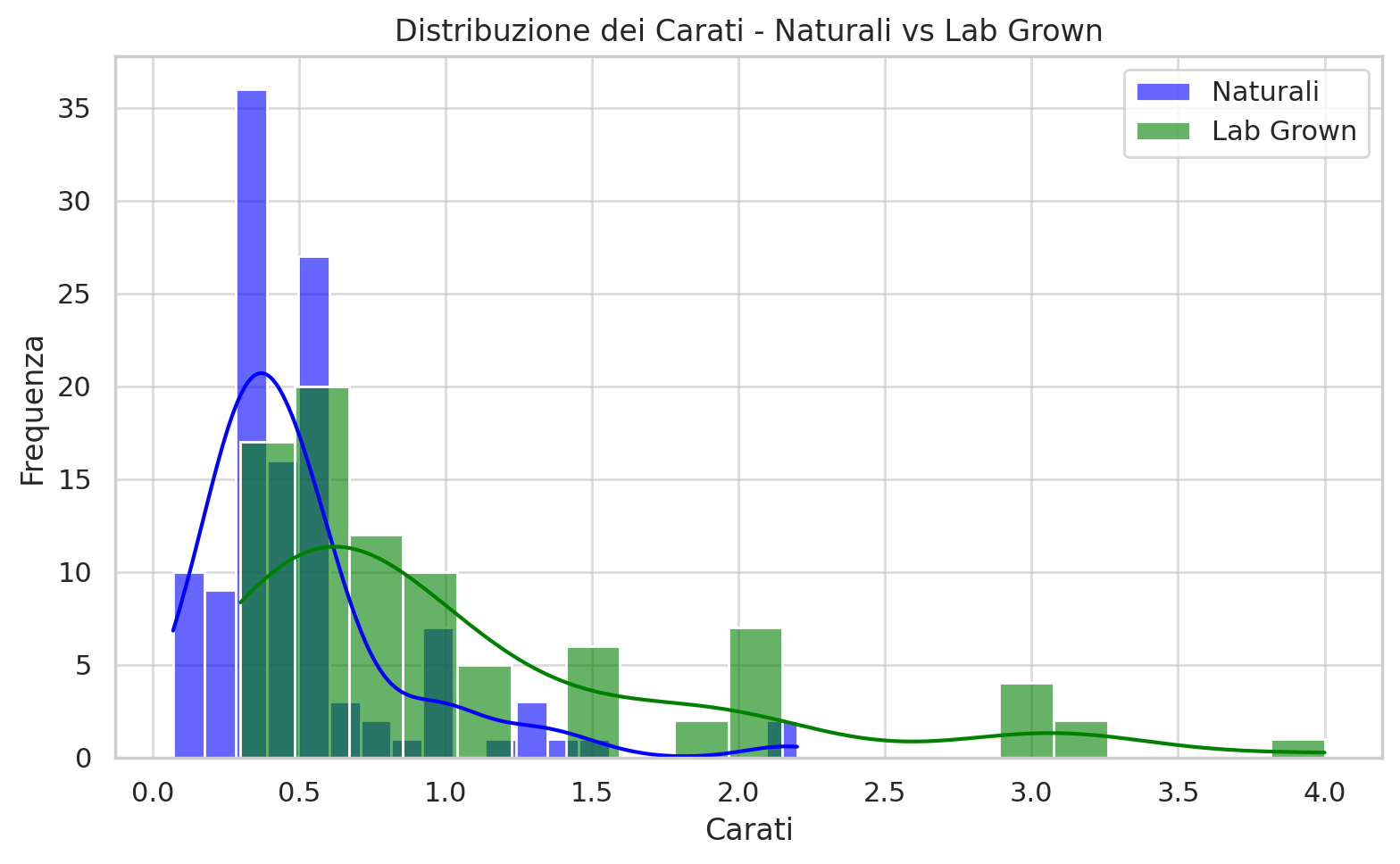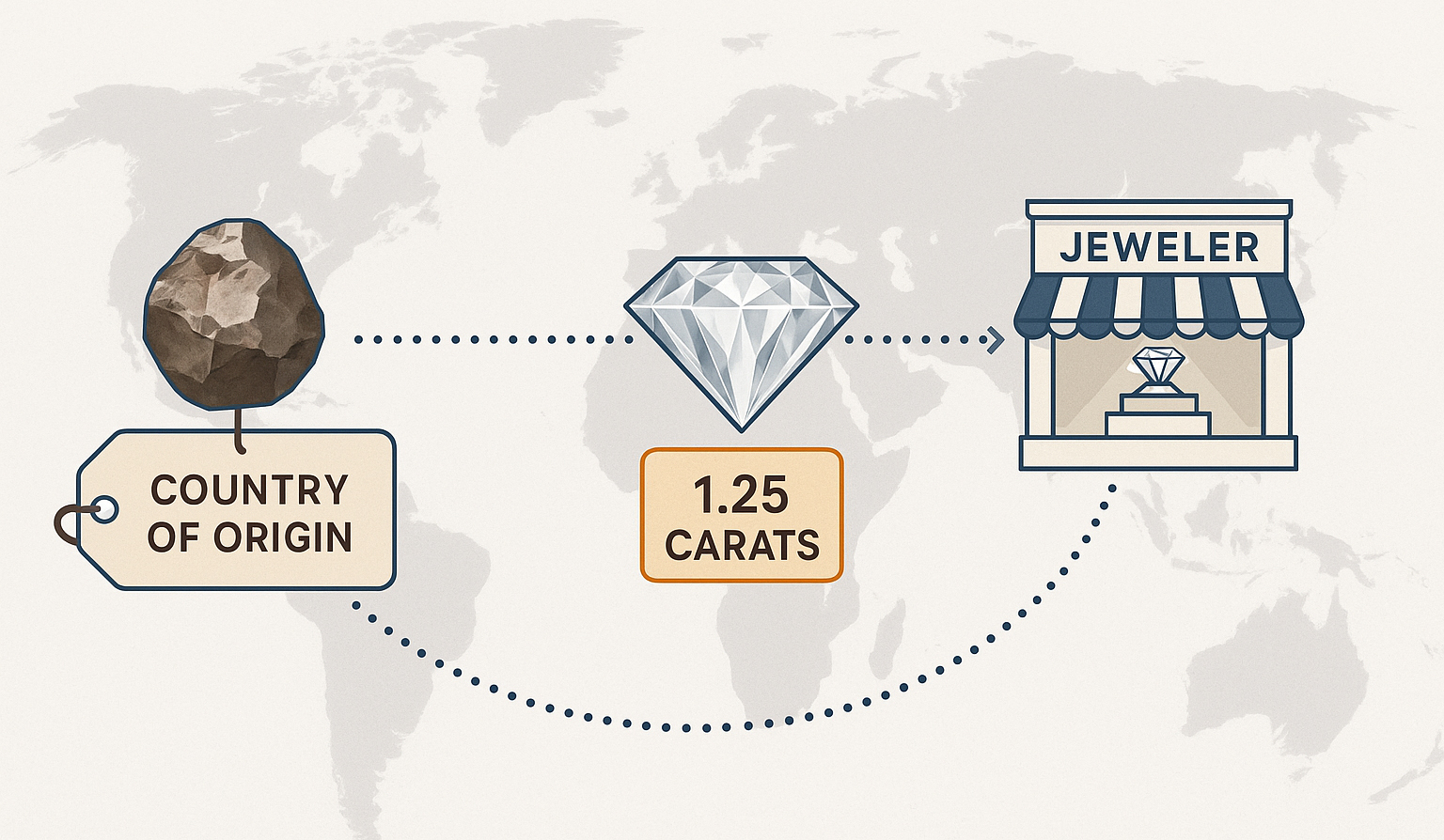Diamondsonline: Market Preferences in June 2025

Flash Story Diamondsonline: Market Preferences in June 2025 GIA Introduces New Classification System for Lab-Grown Diamonds Diamondsonline: Market Preferences in May 2025 Diamondsonline Report Sergio Sorrentino “De Beers Reshapes the Market” Diamondsonline: Market Preferences in June EN: Diamondsonline: Market Preferences in June 2025Sales Rankings Between Natural and Lab-GrownBy Sergio Sorrentino June 2025 sales data from diamondsonline.it confirms key trends in the diamond market, with clear distinctions between natural and lab-grown segments. Shapes:In both categories, Round remains the most sold cut. Natural diamonds: Oval and Heart follow, with Heart cuts gaining traction in custom and symbolic jewelry. Lab-grown: Marquise and Pear rise sharply, showing growing interest in elongated and alternative styles. Carat Weight: Natural: Top-selling sizes are 0.30 ct, 0.50 ct, and 0.40 ct, confirming demand for compact, wearable stones. Lab-grown: 0.50 ct leads, followed by strong growth in 1.50 ct. 1.00 ct remains stable. The lab segment continues to shift toward higher carat weights, driven by price accessibility. Clarity: Natural: Best-sellers are VS1, VS2, and VVS2—offering high visual quality at controlled cost. Lab-grown: Preference shifts toward VVS2, VVS1, and VS1, with a clear focus on top-end clarity grades. Color: Natural: D remains the most requested, followed by G and E. Lab-grown: D, E, and F dominate, showing consistency in demand for high color purity. Key Takeaway:The market shows stable demand for Round cuts and high color/clarity grades across both segments. Lab-grown stones are increasingly selected in larger sizes and higher purity levels, while natural diamonds remain strong in smaller, versatile formats. IT: Diamondsonline: le Preferenze del Mercato a Giugno 2025Classifiche di vendita tra naturali e lab-grownDi Sergio Sorrentino I dati di vendita di giugno 2025 raccolti da diamondsonline.it evidenziano tendenze consolidate e differenze nette tra il segmento dei diamanti naturali e quello dei lab-grown. Taglio:Il taglio Round resta il più venduto in entrambi i segmenti. Naturali: seguono Oval e Heart, quest’ultimo in crescita soprattutto in gioielli personalizzati. Lab-grown: aumentano le vendite di Marquise e Pear, a conferma dell’interesse verso forme allungate e non convenzionali. Carature: Naturali: preferenza per le misure 0.30 ct, 0.50 ct e 0.40 ct, legate a portabilità e prezzo. Lab-grown: domina la 0.50 ct, ma crescono le vendite di 1.50 ct, con 1.00 ct ancora ben posizionata. Il segmento lab-grown mostra un progressivo spostamento verso carature più grandi, grazie alla convenienza economica. Purezza: Naturali: le più richieste sono VS1, VS2 e VVS2, con un buon rapporto qualità/prezzo. Lab-grown: preferenza netta per VVS2, VVS1 e VS1, con attenzione crescente alle fasce più alte. Colore: Naturali: in testa il D, seguito da G ed E. Lab-grown: dominano D, E ed F, con domanda stabile sulle gradazioni più pure. Conclusione:Il mercato premia tagli classici e caratteristiche qualitative elevate. Nei lab-grown crescono le carature e la richiesta di chiarezza superiore; nei naturali continua la domanda su formati compatti e versatili. Source: Posts Lists News Diamondsonline: Market Preferences in June 2025 Diamondsonline News June 24, 2025 News GIA Introduces New Classification System for Lab-Grown Diamonds diamondsonlineshop June 6, 2025 World of Diamonds Diamondsonline: Market Preferences in May 2025 Diamondsonline News May 30, 2025 World of Diamonds Diamondsonline Report diamondsonlineshop May 22, 2025 News Sergio Sorrentino “De Beers Reshapes the Market” diamondsonlineshop May 16, 2025 Blog Sergio Sorrentino “The Natural Diamond Market is Recovering: Are Price Increases on the Horizon?” Diamondsonline News April 1, 2025 News Sergio Sorrentino «The criterion of difference between natural and synthetic is Value» diamondsonlineshop January 27, 2025 News Sergio Sorrentino on Rapaport Market Comment diamondsonlineshop January 27, 2025 Social Links facebookinstagram
GIA Introduces New Classification System for Lab-Grown Diamonds

Flash Story Diamondsonline: Market Preferences in June 2025 GIA Introduces New Classification System for Lab-Grown Diamonds Diamondsonline: Market Preferences in May 2025 Diamondsonline Report Sergio Sorrentino “De Beers Reshapes the Market” GIA Introduces New Classification System for Lab-Grown Diamonds EN: The Gemological Institute of America (GIA) has announced a major update to its classification criteria for lab-grown diamonds, aiming to strengthen the distinction from natural diamonds and offer greater transparency to consumers. In the coming months, lab-grown diamonds will be categorized into two new quality levels: “Premium” and “Standard.” This new classification will be based on a combination of color, clarity, and finish, and will officially replace the traditional grading scale originally developed for natural diamonds. If a lab-grown diamond fails to meet the minimum standards, it will not receive any classification at all. This approach is designed to simplify communication and support clearer, more informed purchasing decisions by clearly separating the two market segments. According to the GIA, over 95% of lab-grown diamonds currently available on the market fall within a very narrow range in terms of color and clarity. This makes the use of a system designed for the broader variety found in natural diamonds unnecessary. In the meantime, the institute will continue to offer its current analysis services for lab-grown diamonds. The new guidelines will be published by the end of the third quarter of 2025, and all previously issued reports will remain valid. IT: GIA introduce una nuova classificazione per i diamanti sintetici Il Gemological Institute of America (GIA) ha annunciato un importante aggiornamento nei criteri di classificazione dei diamanti coltivati in laboratorio, con l’obiettivo di rafforzare la distinzione rispetto ai diamanti naturali e offrire maggiore trasparenza ai consumatori. Nei prossimi mesi, i diamanti sintetici verranno suddivisi in due nuove categorie qualitative: “Premium” e “Standard”. Questa classificazione sarà basata su una combinazione di colore, purezza e finitura, abbandonando definitivamente la scala di valutazione tradizionale pensata per i diamanti naturali. Se un diamante creato in laboratorio non raggiungerà gli standard minimi richiesti, non riceverà alcuna classificazione. Questa scelta intende semplificare la comunicazione e favorire decisioni di acquisto più chiare e consapevoli, distinguendo in modo netto tra le due tipologie di prodotto. Secondo quanto comunicato dal GIA, oltre il 95% dei diamanti sintetici oggi in commercio presenta caratteristiche molto simili in termini di colore e purezza. Ciò rende superfluo l’uso di un sistema di classificazione pensato per l’ampia varietà dei diamanti naturali. Nel frattempo, l’istituto continuerà a offrire i servizi attuali di analisi per i diamanti coltivati in laboratorio. Le nuove linee guida saranno rese pubbliche entro la fine del terzo trimestre 2025, mentre tutti i certificati già emessi resteranno validi. Source: Posts Lists News Diamondsonline: Market Preferences in June 2025 Diamondsonline News June 24, 2025 News GIA Introduces New Classification System for Lab-Grown Diamonds diamondsonlineshop June 6, 2025 World of Diamonds Diamondsonline: Market Preferences in May 2025 Diamondsonline News May 30, 2025 World of Diamonds Diamondsonline Report diamondsonlineshop May 22, 2025 News Sergio Sorrentino “De Beers Reshapes the Market” diamondsonlineshop May 16, 2025 Blog Sergio Sorrentino “The Natural Diamond Market is Recovering: Are Price Increases on the Horizon?” Diamondsonline News April 1, 2025 News Sergio Sorrentino «The criterion of difference between natural and synthetic is Value» diamondsonlineshop January 27, 2025 News Sergio Sorrentino on Rapaport Market Comment diamondsonlineshop January 27, 2025 Social Links facebookinstagram
Diamondsonline: Market Preferences in May 2025

Flash Story Diamondsonline: Market Preferences in June 2025 GIA Introduces New Classification System for Lab-Grown Diamonds Diamondsonline: Market Preferences in May 2025 Diamondsonline Report Sergio Sorrentino “De Beers Reshapes the Market” Diamondsonline: Market Preferences in May 2025 EN: Diamondsonline: Market Preferences in May 2025 Sales Rankings Between Natural and Lab-GrownBy Sergio Sorrentino The month of May confirmed some ongoing trends in the diamond sector while also revealing new signals—insights that are valuable for professionals in jewelry and trading. Sales data from diamondsonline.it, an Italian platform specializing in natural and lab-grown diamonds, provides a clear snapshot of current market preferences. When it comes to shapes, the Round cut remains the most favored choice—a timeless classic that shows no signs of decline. This shape continues to represent the perfect blend of brilliance and versatility, making it dominant across both natural and lab-grown diamonds. However, among natural stones, there is a steady rise in demand for fancy cuts like Pear and Oval—both offering visual volume and an elegant presence, especially sought after for modern and custom settings. In lab-grown diamonds, Pear and Emerald cuts stand out, indicating that even budget-conscious customers are seeking distinctive and contemporary lines. In terms of carat weight, natural diamonds see strong sales in the 0.30 ct range, followed by 0.50 ct and 1.00 ct stones. These sizes strike a good balance between value, visibility, and everyday wearability. The situation is different for lab-grown diamonds: here, the 1.00 ct cut is the top seller, but there’s a noticeable increase in sales of 1.50 ct and 2.00 ct stones as well. Their affordable pricing makes these sizes not only desirable but truly accessible. Clarity remains a key parameter. For natural diamonds, VS1 and VVS2 dominate, followed by VS2—offering excellent visual performance without entering prohibitive price ranges. In lab-grown stones, quality is not sacrificed either: VS1 and VVS1 are the best-selling grades, confirming that buyers are choosing lab-grown options without compromising on beauty and clarity. Finally, color. Among natural diamonds, D ranks at the top, followed by G and E—cool, bright tones that deliver elegance and purity at first glance. In lab-grown diamonds, the highest grades—D, E, and F—still lead the rankings, showing that even in this category, the pursuit of the “perfect white” remains a key driver of purchase decisions. In conclusion, the market remains solid but is evolving in its details. Those who can read between the lines know that having the “right diamond” isn’t enough: it takes well-balanced proportions, current shapes, and a refreshed purchasing strategy. The choices made in May prove this with clarity. IT: Diamondsonline: le Preferenze del Mercato a Maggio 2025Classifiche di vendita tra naturali e lab-grownDi Sergio Sorrentino Il mese di maggio ha confermato alcune tendenze già in atto nel settore dei diamanti, ma ha anche fatto emergere segnali nuovi, utili per chi opera nel mondo della gioielleria e del trading. L’analisi delle vendite su diamondsonline.it, piattaforma italiana specializzata in diamanti naturali e lab-grown, offre uno spaccato chiaro delle attuali preferenze di mercato. Tra le forme, il taglio Round continua a essere la scelta più apprezzata: un classico che non conosce flessioni. È una forma che rappresenta ancora oggi la combinazione perfetta tra brillantezza e versatilità, e questo la rende dominante sia tra i naturali sia tra i lab-grown. Tuttavia, nei diamanti naturali assistiamo a una crescita costante di tagli fancy come Pear e Oval, due forme che offrono volume visivo e una presenza elegante, particolarmente richieste per montature moderne e personalizzate. Nei coltivati in laboratorio, spiccano invece Pear ed Emerald, segnale che anche il pubblico più attento al budget cerca linee nuove e distintive. Sul fronte delle carature, i naturali mostrano una forte incidenza delle pietre da 0.30 ct, seguite da quelle da 0.50 e 1.00 ct. Si tratta di pezzature che offrono un buon equilibrio tra valore, visibilità e possibilità di utilizzo in gioielli quotidiani. Diversa la situazione nei lab-grown: qui, il taglio da 1.00 ct è il più venduto, ma aumentano in modo deciso anche le vendite di pietre da 1.50 e 2.00 ct. L’accessibilità di prezzo rende queste dimensioni non solo desiderabili, ma concretamente acquistabili. La purezza resta un parametro chiave. Nei naturali, dominano le VS1 e le VVS2, seguite da VS2: livelli che garantiscono un’eccellente resa visiva, senza andare su fasce di prezzo proibitive. Nei lab-grown, la qualità non viene messa in secondo piano: VS1 e VVS1 sono le più vendute, a riprova del fatto che il consumatore è disposto a scegliere il coltivato, ma senza rinunciare alla bellezza e alla limpidezza. Infine, i colori. Nei naturali, il gradino più alto del podio va al D, seguito da G ed E: tonalità fredde, luminose, che restituiscono eleganza e purezza al primo sguardo. Nei lab-grown prevalgono ancora le scale altissime — D, E e F — dimostrando come anche qui, la ricerca del “bianco perfetto” sia un driver d’acquisto essenziale. In conclusione, il mercato conferma la sua solidità, ma evolve nei dettagli. Chi sa leggere tra le righe sa che non basta avere “il diamante giusto”: servono proporzioni ben calibrate, forme attuali e una strategia d’acquisto aggiornata. Le scelte di maggio lo dimostrano con chiarezza. Source: Posts Lists News Diamondsonline: Market Preferences in June 2025 Diamondsonline News June 24, 2025 News GIA Introduces New Classification System for Lab-Grown Diamonds diamondsonlineshop June 6, 2025 World of Diamonds Diamondsonline: Market Preferences in May 2025 Diamondsonline News May 30, 2025 World of Diamonds Diamondsonline Report diamondsonlineshop May 22, 2025 News Sergio Sorrentino “De Beers Reshapes the Market” diamondsonlineshop May 16, 2025 Blog Sergio Sorrentino “The Natural Diamond Market is Recovering: Are Price Increases on the Horizon?” Diamondsonline News April 1, 2025 News Sergio Sorrentino «The criterion of difference between natural and synthetic is Value» diamondsonlineshop January 27, 2025 News Sergio Sorrentino on Rapaport Market Comment diamondsonlineshop January 27, 2025 Social Links facebookinstagram
Diamondsonline Report

Flash Story Diamondsonline: Market Preferences in June 2025 GIA Introduces New Classification System for Lab-Grown Diamonds Diamondsonline: Market Preferences in May 2025 Diamondsonline Report Sergio Sorrentino “De Beers Reshapes the Market” Diamondsonline: Market Preferences in May 2025 EN: Diamondsonline: Market Preferences in May 2025 Sales Rankings Between Natural and Lab-GrownBy Sergio Sorrentino The month of May confirmed some ongoing trends in the diamond sector while also revealing new signals—insights that are valuable for professionals in jewelry and trading. Sales data from diamondsonline.it, an Italian platform specializing in natural and lab-grown diamonds, provides a clear snapshot of current market preferences. When it comes to shapes, the Round cut remains the most favored choice—a timeless classic that shows no signs of decline. This shape continues to represent the perfect blend of brilliance and versatility, making it dominant across both natural and lab-grown diamonds. However, among natural stones, there is a steady rise in demand for fancy cuts like Pear and Oval—both offering visual volume and an elegant presence, especially sought after for modern and custom settings. In lab-grown diamonds, Pear and Emerald cuts stand out, indicating that even budget-conscious customers are seeking distinctive and contemporary lines. In terms of carat weight, natural diamonds see strong sales in the 0.30 ct range, followed by 0.50 ct and 1.00 ct stones. These sizes strike a good balance between value, visibility, and everyday wearability. The situation is different for lab-grown diamonds: here, the 1.00 ct cut is the top seller, but there’s a noticeable increase in sales of 1.50 ct and 2.00 ct stones as well. Their affordable pricing makes these sizes not only desirable but truly accessible. Clarity remains a key parameter. For natural diamonds, VS1 and VVS2 dominate, followed by VS2—offering excellent visual performance without entering prohibitive price ranges. In lab-grown stones, quality is not sacrificed either: VS1 and VVS1 are the best-selling grades, confirming that buyers are choosing lab-grown options without compromising on beauty and clarity. Finally, color. Among natural diamonds, D ranks at the top, followed by G and E—cool, bright tones that deliver elegance and purity at first glance. In lab-grown diamonds, the highest grades—D, E, and F—still lead the rankings, showing that even in this category, the pursuit of the “perfect white” remains a key driver of purchase decisions. In conclusion, the market remains solid but is evolving in its details. Those who can read between the lines know that having the “right diamond” isn’t enough: it takes well-balanced proportions, current shapes, and a refreshed purchasing strategy. The choices made in May prove this with clarity. IT: Diamondsonline: le Preferenze del Mercato a Maggio 2025Classifiche di vendita tra naturali e lab-grownDi Sergio Sorrentino Il mese di maggio ha confermato alcune tendenze già in atto nel settore dei diamanti, ma ha anche fatto emergere segnali nuovi, utili per chi opera nel mondo della gioielleria e del trading. L’analisi delle vendite su diamondsonline.it, piattaforma italiana specializzata in diamanti naturali e lab-grown, offre uno spaccato chiaro delle attuali preferenze di mercato. Tra le forme, il taglio Round continua a essere la scelta più apprezzata: un classico che non conosce flessioni. È una forma che rappresenta ancora oggi la combinazione perfetta tra brillantezza e versatilità, e questo la rende dominante sia tra i naturali sia tra i lab-grown. Tuttavia, nei diamanti naturali assistiamo a una crescita costante di tagli fancy come Pear e Oval, due forme che offrono volume visivo e una presenza elegante, particolarmente richieste per montature moderne e personalizzate. Nei coltivati in laboratorio, spiccano invece Pear ed Emerald, segnale che anche il pubblico più attento al budget cerca linee nuove e distintive. Sul fronte delle carature, i naturali mostrano una forte incidenza delle pietre da 0.30 ct, seguite da quelle da 0.50 e 1.00 ct. Si tratta di pezzature che offrono un buon equilibrio tra valore, visibilità e possibilità di utilizzo in gioielli quotidiani. Diversa la situazione nei lab-grown: qui, il taglio da 1.00 ct è il più venduto, ma aumentano in modo deciso anche le vendite di pietre da 1.50 e 2.00 ct. L’accessibilità di prezzo rende queste dimensioni non solo desiderabili, ma concretamente acquistabili. La purezza resta un parametro chiave. Nei naturali, dominano le VS1 e le VVS2, seguite da VS2: livelli che garantiscono un’eccellente resa visiva, senza andare su fasce di prezzo proibitive. Nei lab-grown, la qualità non viene messa in secondo piano: VS1 e VVS1 sono le più vendute, a riprova del fatto che il consumatore è disposto a scegliere il coltivato, ma senza rinunciare alla bellezza e alla limpidezza. Infine, i colori. Nei naturali, il gradino più alto del podio va al D, seguito da G ed E: tonalità fredde, luminose, che restituiscono eleganza e purezza al primo sguardo. Nei lab-grown prevalgono ancora le scale altissime — D, E e F — dimostrando come anche qui, la ricerca del “bianco perfetto” sia un driver d’acquisto essenziale. In conclusione, il mercato conferma la sua solidità, ma evolve nei dettagli. Chi sa leggere tra le righe sa che non basta avere “il diamante giusto”: servono proporzioni ben calibrate, forme attuali e una strategia d’acquisto aggiornata. Le scelte di maggio lo dimostrano con chiarezza. Source: Posts Lists News Diamondsonline: Market Preferences in June 2025 Diamondsonline News June 24, 2025 News GIA Introduces New Classification System for Lab-Grown Diamonds diamondsonlineshop June 6, 2025 World of Diamonds Diamondsonline: Market Preferences in May 2025 Diamondsonline News May 30, 2025 World of Diamonds Diamondsonline Report diamondsonlineshop May 22, 2025 News Sergio Sorrentino “De Beers Reshapes the Market” diamondsonlineshop May 16, 2025 Blog Sergio Sorrentino “The Natural Diamond Market is Recovering: Are Price Increases on the Horizon?” Diamondsonline News April 1, 2025 News Sergio Sorrentino «The criterion of difference between natural and synthetic is Value» diamondsonlineshop January 27, 2025 News Sergio Sorrentino on Rapaport Market Comment diamondsonlineshop January 27, 2025 Social Links facebookinstagram
Sergio Sorrentino “De Beers Reshapes the Market”

Sergio Sorrentino “De Beers Reshapes the Market: Exit from Lab-Grown Diamonds, Focus on Traceability and Natural Value” Sergio Sorrentino EN: De Beers is implementing a market repositioning strategy focused on natural diamonds and supply chain transparency. This strategy includes the closure of its lab-grown diamond brand Lightbox, the reduction of the number of sightholders, and investment in traceability systems. Exit from the Lab-Grown Diamond Market De Beers has announced its intention to close its jewelry brand with lab-grown diamonds, Lightbox, to focus exclusively on natural diamonds. This decision reflects the company’s commitment to promoting and supporting natural diamonds in the jewelry sector. Reduction of Sightholders De Beers plans to further reduce the number of its sightholders starting from January 2026, in line with its Origins strategy. Currently, the company has about 60 sightholders and aims to decrease this number to create partnerships that generate value. Investments in Traceability De Beers has announced that it will provide country-of-origin data for all rough diamonds over 1.25 carats from its mines. This step represents a commitment to greater transparency and traceability in the diamond supply chain. Selective Discounts to Sightholders There have been speculations that De Beers has offered discounts to certain sightholders since the beginning of the year. It is unclear how many received these special prices, what the terms were, and whether this represents a significant deviation from past practices. Conclusion De Beers’ recent moves indicate a strategy aimed at strengthening the perceived value of natural diamonds by reducing supply, emphasizing traceability, and selectively supporting key partners. This strategy could lead to the repositioning of natural diamonds as a symbol of authenticity and ethical luxury. IT: De Beers sta attuando una strategia di riposizionamento nel mercato dei diamanti, focalizzandosi sui diamanti naturali e sulla trasparenza della filiera. Questa strategia include la chiusura del marchio di diamanti sintetici Lightbox, la riduzione del numero di sightholder e l’investimento in sistemi di tracciabilità. Uscita dal mercato dei diamanti sintetici De Beers ha annunciato l’intenzione di chiudere il suo marchio di gioielli con diamanti sintetici, Lightbox, per concentrarsi sui diamanti naturali. Questa decisione riflette l’impegno dell’azienda nel promuovere e supportare i diamanti naturali nel settore della gioielleria. Riduzione dei sightholder De Beers prevede di ridurre ulteriormente il numero dei suoi sightholder a partire da gennaio 2026, in linea con la sua strategia Origins. Attualmente, l’azienda ha circa 60 sightholder e mira a diminuire questo numero per creare partnership che generino valore. Investimenti nella tracciabilità De Beers ha annunciato che fornirà dati sul paese di origine per tutti i diamanti grezzi superiori a 1,25 carati provenienti dalle sue miniere. Questo passo rappresenta un impegno verso una maggiore trasparenza e tracciabilità nella filiera dei diamanti. Sconti selettivi ai sightholder Ci sono state speculazioni secondo cui De Beers avrebbe offerto sconti a determinati sightholder sin dall’inizio dell’anno. Non è chiaro quanti di loro abbiano ricevuto questi prezzi speciali, quali fossero i termini e se ciò rappresenti una deviazione significativa dalle pratiche passate. Conclusione Le recenti mosse di De Beers indicano una strategia volta a rafforzare il valore percepito dei diamanti naturali, attraverso la riduzione dell’offerta, l’enfasi sulla tracciabilità e il supporto selettivo ai partner chiave. Questa strategia potrebbe portare a un riposizionamento del diamante naturale come simbolo di autenticità e lusso sostenibile. Source: Posts Lists News Diamondsonline: Market Preferences in June 2025 Diamondsonline News June 24, 2025 News GIA Introduces New Classification System for Lab-Grown Diamonds diamondsonlineshop June 6, 2025 World of Diamonds Diamondsonline: Market Preferences in May 2025 Diamondsonline News May 30, 2025 World of Diamonds Diamondsonline Report diamondsonlineshop May 22, 2025 News Sergio Sorrentino “De Beers Reshapes the Market” diamondsonlineshop May 16, 2025 Blog Sergio Sorrentino “The Natural Diamond Market is Recovering: Are Price Increases on the Horizon?” Diamondsonline News April 1, 2025 News Sergio Sorrentino «The criterion of difference between natural and synthetic is Value» diamondsonlineshop January 27, 2025 News Sergio Sorrentino on Rapaport Market Comment diamondsonlineshop January 27, 2025 Social Links facebookinstagram
Sergio Sorrentino “The Natural Diamond Market is Recovering: Are Price Increases on the Horizon?”

According to analysts, one key factor behind this trend is the reduction in production by major industry players such as De Beers, which has implemented supply containment strategies to counter downward pressure on prices.
Sergio Sorrentino «The criterion of difference between natural and synthetic is Value»

The diamond supply market is experiencing strong growth after the 2020 setback caused by the pandemic. We spoke about this with Sergio Sorrentino, founder of the diamondsonline.it platform, owner of E-Motion Natural Diamonds, a leading company in the marketing of natural diamonds and owner of Easydiam, “which is another company”, the entrepreneur points out, “not born from a rib of E-Motion but which shines its own light and deals in Lab-Grown diamonds”. Natural and lab-made diamonds. Sorrentino, if you had to choose one criterion that differentiates them what would you point to?“The first big difference is value. We are lucky: the Italian market is very traditional, there is a great focus on value.
Sergio Sorrentino on Rapaport Market Comment

International Diamond Market: A Look at Current Trends
(Source: RapNet)
The diamond market reflects the usual seasonal slowdown in the United States following the holidays, with stable demand for round stones between 0.30 and 0.69 ct, D-F, IF-VVS2. De Beers has decided to keep prices stable for the January sight, while allowing buybacks of up to 20%. In India, the duty-free import of polished stones below 0.25 ct could significantly impact sourcing costs.

